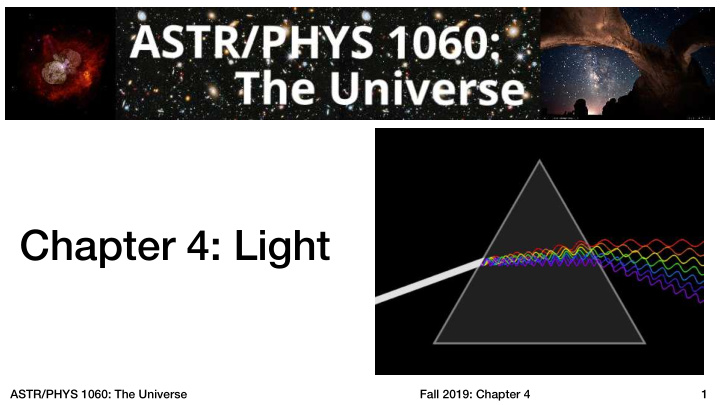



Chapter 4: Light ASTR/PHYS 1060: The Universe Fall 2019: Chapter 4 � 1
Tacoma Narrows Light is a wave Bridge, 1940 https://www.youtube.com/watch?v=XggxeuFDaDU ASTR/PHYS 1060: The Universe Fall 2019: Chapter 4 � 2
ASTR/PHYS 1060: The Universe Fall 2019: Chapter 4 � 3
Light is an “electromagnetic wave” ASTR/PHYS 1060: The Universe Fall 2019: Chapter 4 � 4
ASTR/PHYS 1060: The Universe Fall 2019: Chapter 4 � 5
Speed of Light: can you explain how we can measure it via this method? ASTR/PHYS 1060: The Universe Fall 2019: Chapter 4 � 6
A light-year is a unit of… A) Energy B) Time C) Distance D) Time and Distance ASTR/PHYS 1060: The Universe Fall 2019: Chapter 4 � 7
A light-year is like a parsec, but 3.26 times shorter ASTR/PHYS 1060: The Universe Fall 2019: Chapter 4 � 8
Chapter 4: Light Ch. 5 Reading Quiz due this Thursday If you will miss class, email astr1060absence@gmail.com BEFORE the start of that class Midterm 1 Exam on Sept. 19th (1 week from Thursday) ASTR/PHYS 1060: The Universe Fall 2019: Chapter 4 � 9
Light is “quantized” Its energy is proportional to frequency ASTR/PHYS 1060: The Universe Fall 2019: Chapter 4 � 10
Electromagnetic Spectrum ASTR/PHYS 1060: The Universe Fall 2019: Chapter 4 � 11
What type of emission do we see only from the most energetic events? A) Visible Light B) Radio Waves C) Ultraviolet Light D) Gamma Rays ASTR/PHYS 1060: The Universe Fall 2019: Chapter 4 � 12
What is a spectrum? Intensity/Brightness Wavelength [nm] ASTR/PHYS 1060: The Universe Fall 2019: Chapter 4 � 13
Which object would look bluer? Which object would look brighter? Intensity/Brightness A B Wavelength [nm] ASTR/PHYS 1060: The Universe Fall 2019: Chapter 4 � 14
Emission and Absorption Lines Emission sticks up Absorption sticks down ASTR/PHYS 1060: The Universe Fall 2019: Chapter 4 � 15
ASTR/PHYS 1060: The Universe Fall 2019: Chapter 4 � 16
ASTR/PHYS 1060: The Universe Fall 2019: Chapter 4 � 17
Our eyes are telescopes! Works like a refractor amount of refraction depends on the wavelength of light — cannot focus red and blue light at the same time! ASTR/PHYS 1060: The Universe Fall 2019: Chapter 4 � 18
Astronomical Sources are “infinitely” far away ASTR/PHYS 1060: The Universe Fall 2019: Chapter 4 � 19
Use reflecting telescopes due to less chromatic aberration and easier to build large ones ASTR/PHYS 1060: The Universe Fall 2019: Chapter 4 � 20
xkcd.com ASTR/PHYS 1060: The Universe Fall 2019: Chapter 4 � 21
Why do astronomers keep making telescopes bigger? A) Increase the field of view of a single observation B) Resolve finer details (better image resolution) C) Collect more light D) Astronomers need to compensate for something ASTR/PHYS 1060: The Universe Fall 2019: Chapter 4 � 22
Telescope Resolution ASTR/PHYS 1060: The Universe Fall 2019: Chapter 4 � 23
What is “angular resolution”? A) The angular size of a pixel of a CCD or any detector B) The smallest resolving power of a telescope’s mirrors C) The angles light must be bent by mirrors D) A solution to a tricky problem in optical design ASTR/PHYS 1060: The Universe Fall 2019: Chapter 4 � 24
Making Images Charged Coupled Devices (CCDs) ASTR/PHYS 1060: The Universe Fall 2019: Chapter 4 � 25
Filters ASTR/PHYS 1060: The Universe Fall 2019: Chapter 4 � 26
“True” Color “False” Color ASTR/PHYS 1060: The Universe Fall 2019: Chapter 4 � 27
False color images can be made using light at any wavelength, from radio to gamma ray “True” Color ASTR/PHYS 1060: The Universe Fall 2019: Chapter 4 � 28
If you were designing a telescope to survey the entire sky to study the brightest stars in several colors over the course of a year, what features would you want it to have? large/small FOV? large/small mirrors (collecting area)? 1 big telescope vs. several smaller telescopes? a refracting or reflecting design? Discuss in small groups! ASTR/PHYS 1060: The Universe Fall 2019: Chapter 4 � 29
Brief Tour of the Universe at Different Wavelengths high energy low energy ASTR/PHYS 1060: The Universe Fall 2019: Chapter 4 � 30
Radio (broad band) Jupiter Centaurus A Galaxy Captured charged particles from the Sun Jets accelerated by a supermassive black hole ASTR/PHYS 1060: The Universe Fall 2019: Chapter 4 � 31
Radio (narrow band) Spiral Galaxy Hydrogen gas through emission line at 21 cm Visible light (stars - images at the same scale) ASTR/PHYS 1060: The Universe Fall 2019: Chapter 4 � 32
Infrared - Dust Clouds Visible Light Infrared Light (1-2 μ m) ASTR/PHYS 1060: The Universe Fall 2019: Chapter 4 � 33
Ultraviolet - Massive Stars M81 ASTR/PHYS 1060: The Universe Fall 2019: Chapter 4 � 34
X-ray - Dead Stars X-ray Infrared (Chandra) (Hubble) ASTR/PHYS 1060: The Universe Fall 2019: Chapter 4 � 35
The Crab Nebula Crab Nebula (Remains of a supernova, supernova explosion left a pulsar at the with a pulsar at the center that energizes surrounding gas middle) ASTR/PHYS 1060: The Universe Fall 2019: Chapter 4 � 36
Radio/X-ray - Million Degree Gas in Galaxy Clusters Red = Radio Yellow = Visible Blue = X-ray ASTR/PHYS 1060: The Universe Fall 2019: Chapter 4 � 37
Andromeda Galaxy - Our Nearest Neighbor ASTR/PHYS 1060: The Universe Fall 2019: Chapter 4 � 38
ASTR/PHYS 1060: The Universe Fall 2019: Chapter 4 � 39
Recommend
More recommend